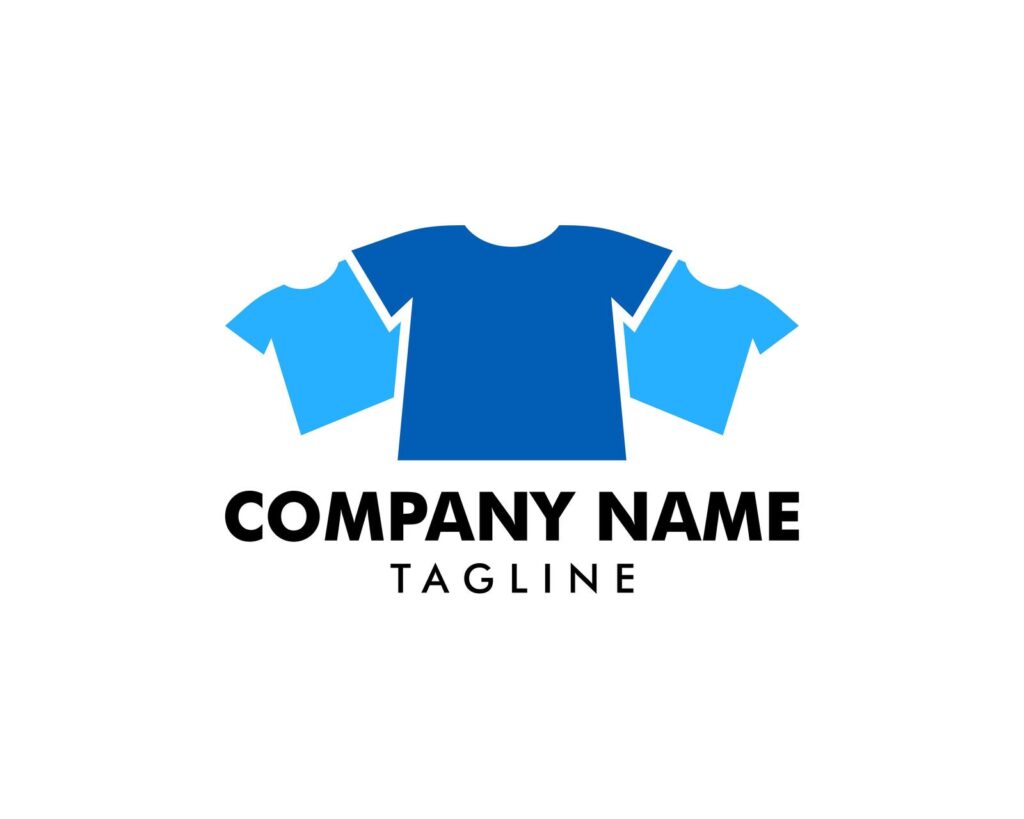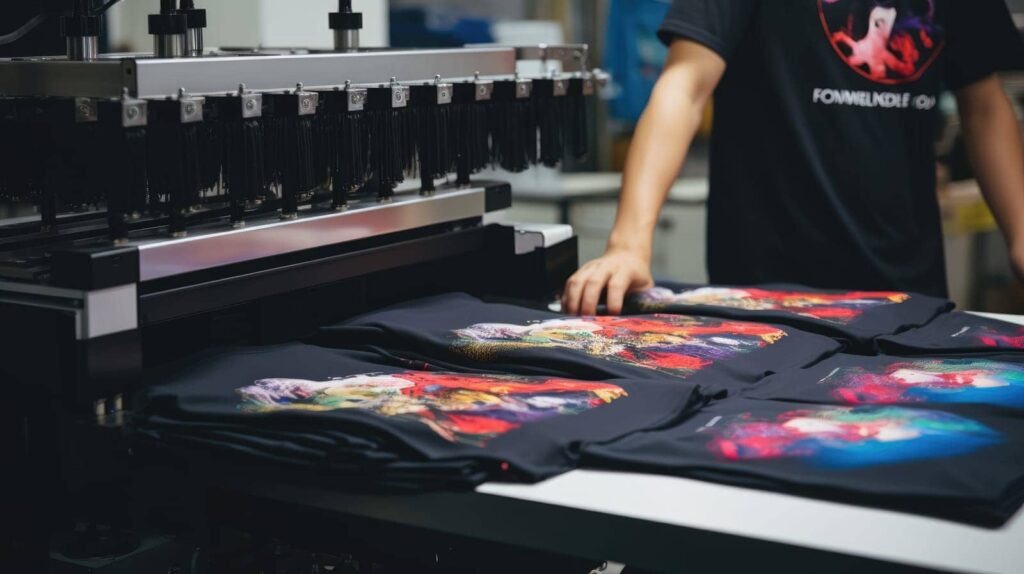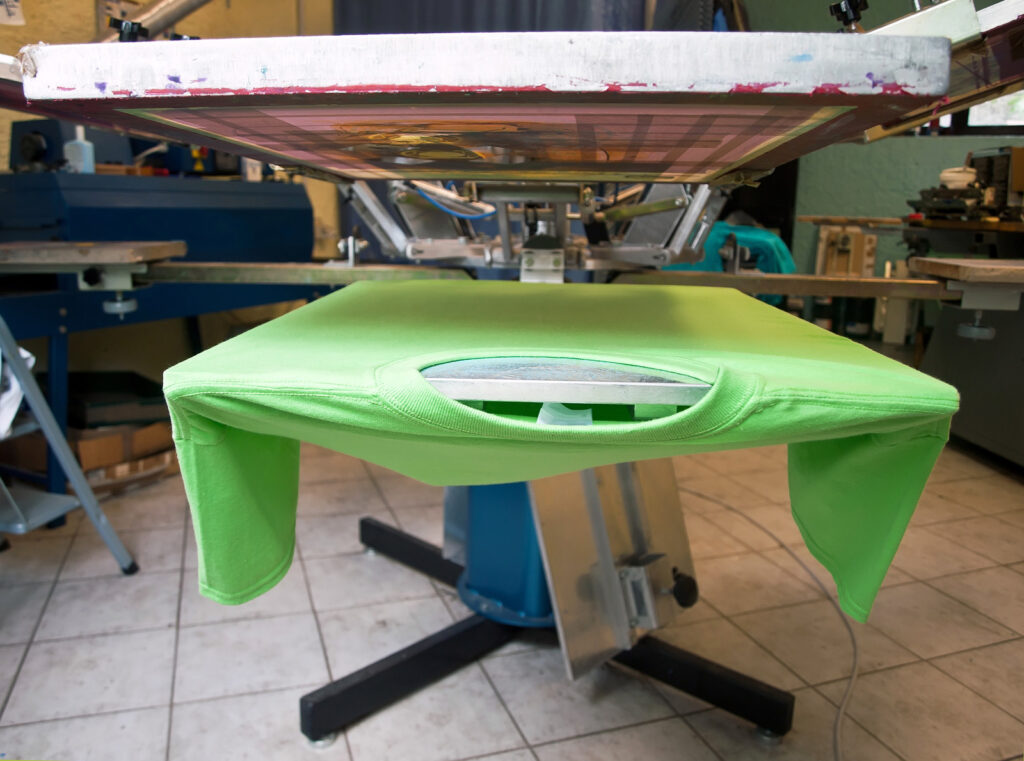Address
Dubai, UAE
Work Hours
Monday to Friday: 9AM - 6PM
Weekend: 10AM - 5PM

Do you want to learn how to make money with print-on-demand? This blog post will guide you through the process of unlocking the potential of this business model and turning your creative designs into profits.
Print-on-demand is a business model that allows you to sell custom-designed products without having to deal with inventory, production, or shipping. Instead, items are printed or created only when an order is placed, making it a cost-effective and low-risk way to start a business.
Print on demand, often abbreviated as POD business, is a retail fulfillment method where products are only printed or created once an order is received. This means that you don’t have to hold any inventory or invest in large quantities of products upfront.
Instead of purchasing products in bulk and storing them in a warehouse, you work with a print provider to fulfill orders as they come in. This means that you can offer a wide range of products to your customers without the risk of overstocking or underestimating demand.
This business model is popular among artists, designers, and entrepreneurs looking to start an online business with minimal upfront costs. With print-on-demand, you can create custom products at a fraction of the cost of traditional manufacturing, making it an accessible option for anyone looking to start an e-commerce store.

Print on demand is a business model where you work with a supplier to customize white-label products (such as t-shirts, mugs, phone cases, and home decor) with your designs and sell them on a per-order basis. When a customer places an order for a product with your design, the print-on-demand company will fulfill the order by printing the design on the chosen item, such as a t-shirt, mug, or phone case, and then ship it directly to the customer.
Before diving into print-on-demand, it’s essential to research popular niches and identify which ones have a high demand for custom-designed products. However, it’s also important to choose a niche that you are passionate about and have knowledge of. This will help you create designs that resonate with your target audience and set you apart from competitors to earn money.
When selecting a niche, consider your interests, hobbies, and any specific skills or expertise you have. For example, if you love animals, you could create a niche focused on pet owners and animal lovers. If you have a background in fitness and want to sell sports apparel, you could target active individuals looking for workout apparel.
It’s also important to consider the market demand for your chosen niche. Research trends, popular topics, and keywords related to your niche to ensure there is a demand for the products you plan to create. Look for gaps in the market that you can fill with unique designs and products. By choosing a niche with high demand and low competition, you can increase your chances of success and profitability.
Once you have chosen a niche for your print-on-demand business, it’s essential to identify your target audience. Your target audience is the group of people most likely to buy your products and engage with your brand. Understanding your target audience can help you tailor your designs, marketing messages, and product offerings to meet their needs and preferences.
To identify your target audience, consider demographic factors such as age, gender, location, and income level. Think about the interests, values, and lifestyles of your ideal customers. Conduct market research, surveys, and focus groups to gather information about your target audience’s preferences and buying behavior. Use this data to create buyer personas that represent your ideal customers and guide your marketing efforts.
In a competitive market, having a unique selling proposition (USP) can help differentiate your print-on-demand business from competitors and attract customers. Your USP is what sets you apart from other brands and gives customers a reason to choose your products over others. It should communicate the value and benefits of your products in a way that resonates with your target audience.
To find your unique selling proposition, consider what makes your print-on-demand business unique and valuable to customers. This could be your design style, product quality, customer service, or competitive pricing. Highlight the benefits of your products, such as exclusive designs, customizable options, or environmentally friendly materials. Communicate your USP through your branding, website, social media, and marketing campaigns to build brand recognition and loyalty.

One of the key factors that will determine the success of your print-on-demand business is the quality and appeal of your designs. To create custom products that resonate with your audience, it’s important to invest time and effort in creating unique and eye-catching designs according to market trends. Keeping up with market trends is essential for creating designs that sell. Pay attention to popular themes, colors, and styles to ensure that your products are in line with current consumer preferences.
When creating custom products, it’s important to consider the preferences and tastes of your target audience. Think about who your ideal customer is, what they like, and how your products can solve a problem or meet a need for them. By understanding your target audience, you can tailor your designs, messaging, and marketing efforts to resonate with them and drive sales.
Consider incorporating humor, current events, or personalization to add a personal touch to your designs. Additionally, consider creating seasonal collections, limited edition releases, and collaborations with other artists to keep your products fresh and engaging.
Whether you’re an artist, graphic designer, or hobbyist, there are many tools and resources available to help you bring your creative visions to life. You can use Canva or Adobe Express for graphic design. Likewise, platforms like Pinterest can be a great source of inspiration for creating designs that sell. By browsing through different categories, trends, and styles, you can discover new ideas and concepts to incorporate into your products.
Look for popular themes, colors, and motifs that your target audience is interested in, and use them as inspiration for your designs. Remember to test different designs, products, and strategies to see what works best for your business and make adjustments as needed to optimize your results.

If you’re considering starting a print-on-demand business, it’s important to research different print-on-demand companies and choose one that aligns with your business goals. Look for a reliable print provider that offers a wide range of products, competitive pricing, and fast shipping times.
Take into account the company’s degree of customer support and the caliber of printing services it offers. By choosing the right print-on-demand service, you can ensure that your products meet the expectations of your customers and help you build a successful business.
Selecting the right print-on-demand platform is crucial for the success of your business. Printful is one of the most popular options, offering a wide range of products, competitive pricing, and integrations with popular e-commerce platforms like Shopify. Other print-on-demand companies like Printify and Gooten also provide similar services, allowing you to create custom products and sell them online.
Once you’ve created your designs and chosen a print-on-demand service, it’s time to set up your online store and start selling your products. Whether you’re using a platform like Shopify, Etsy, or your own website, there are a few key steps you’ll need to take to get your store up and running. Here is a simple, step-by-step guide.
When setting prices for your products, consider the production costs, platform fees, and your desired profit margin. It’s important to find a balance that allows you to remain competitive while still making a profit. I suggest considering these 10 factors when setting prices and profit margins for your Print-on-Demand businesses:

Marketing is a crucial aspect of running a successful print-on-demand business. To promote your products and reach your target audience, consider using social media marketing, influencer partnerships, content marketing, and other strategies to drive traffic to your store and increase your sales. Create a marketing plan that outlines your goals, target audience, channels, and tactics for reaching your customers and generating leads.
Social media marketing can be a powerful tool for promoting your products and engaging with your audience. Platforms like Instagram, Facebook, Pinterest, and TikTok offer unique opportunities to showcase your products, connect with customers, and build brand awareness. Consider creating visually appealing content, sharing behind-the-scenes stories, running giveaways and contests, and collaborating with influencers to reach a wider audience and drive sales.
Partnering with influencers in your niche can help you reach a larger audience and build credibility for your brand. Identify influencers whose followers align with your target market and collaborate on promotions or sponsored posts. Influencer marketing can foster a sense of community around your brand by connecting you with like-minded individuals who share your passion for print-on-demand products.
Influencers can introduce your print-on-demand products to a wide audience, increasing brand visibility and recall. When influencers vouch for your products, it lends credibility to your brand and establishes you as an authority in the industry. Well-executed influencer marketing campaigns can result in a significant boost in sales, especially if the influencer offers exclusive promotions or discounts.
Another effective marketing strategy for print-on-demand businesses is content marketing. By creating blog posts, videos, tutorials, and other content that showcases your products and provides value to your audience, you can attract organic traffic to your store and build relationships with potential customers. Consider sharing your expertise, telling your brand story, and highlighting the benefits of your products to engage your audience and drive conversions.
Optimizing your online store and content for search engines can help drive organic traffic and improve your visibility. Use relevant keywords, optimize product descriptions, and create valuable content to improve your store’s search engine rankings.

After an order is placed on your e-commerce website, the print-on-demand company takes over the production and shipping processes. This means that they will print the product, package it, and ship it directly to the customer. It’s important for you, as the business owner, to familiarize yourself with the fulfillment process to ensure a smooth experience for your customers.
This includes understanding the production time, shipping options, and any additional fees that may be associated with the fulfillment process. It’s also important to communicate this information clearly to your customers so that they know what to expect when placing an order.
Additionally, you should regularly check in with the print-on-demand company to ensure that orders are being fulfilled in a timely and efficient manner. This will help to maintain a positive reputation for your business and keep customers satisfied with their purchases. By understanding and staying on top of the fulfillment process, you can ensure a successful and hassle-free experience for both you and your customers.
In today’s competitive market, delivering exceptional customer service is crucial to building a loyal customer base. Customers have countless options when it comes to purchasing products or services, so it is essential to make them feel valued and supported throughout their purchasing journey.
One of the key aspects of providing exceptional customer service is being responsive to inquiries. Whether it’s through email, phone calls, or social media, customers expect timely and helpful responses to their questions and concerns. This shows that you value their time and are willing to go above and beyond to assist them.
Another important aspect of exceptional customer service is addressing any issues promptly. No business is perfect, and mistakes are bound to happen. However, it is how a company handles these mistakes that can make or break a customer’s experience. By addressing and resolving issues promptly, you show that you care about your customers and their satisfaction. This can turn a potentially negative experience into a positive one and can even earn you a loyal customer.
In addition to being responsive and addressing issues, it is crucial to make your customers feel valued throughout their purchasing journey. This can include small gestures such as personalized thank-you notes or surprise discounts. It is also important to listen to your customers’ feedback and make changes or improvements based on their
No matter how great your products are, there will inevitably be instances where customers need to return or exchange them. This could be due to a variety of reasons, such as receiving the wrong item, receiving a damaged item, or simply changing their mind about the purchase. As a business owner, it is crucial to have a clear and customer-friendly return policy in place to handle these situations professionally and efficiently.
First and foremost, your return policy should be easily accessible and clearly stated on your website and any other platforms where you sell your products. This will help customers understand what to expect in case they need to return or exchange an item.
Next, your return policy should be fair and reasonable for both your business and your customers. This means setting a time limit for returns and exchanges, as well as outlining any conditions for products to be eligible for a return or exchange.
It is also important to have a customer-friendly approach to returns and exchanges. This means being understanding and accommodating to customers’ needs and concerns. For example, if a customer wants to return an item that is slightly past the return window, consider making an exception and allowing the return. This can help build customer loyalty and trust in your brand. In addition, having a smooth and efficient process

Once you have established your print-on-demand business and started making sales, it’s time to focus on growing your business and increasing your revenue. There are many ways to scale your print-on-demand business, including adding new products, expanding your marketing efforts, and optimizing your operations.
As your print-on-demand business grows, it can become overwhelming to handle all aspects of the business on your own. That’s when it’s time to consider outsourcing tasks such as customer service, marketing, or design work to free up your time and focus on strategic business growth.
Outsourcing allows you to delegate tasks to professionals who have the expertise and experience to handle them efficiently. This not only saves you time but also ensures that these tasks are done effectively. For example, outsourcing customer service can help you provide better and faster support to your customers, leading to higher satisfaction and retention rates.
Outsourcing marketing can help you reach a wider audience and attract new customers, while outsourcing design work can ensure that your products are visually appealing and stand out from your competitors. By outsourcing these tasks, you can focus on the bigger picture and make important decisions that will drive your business forward.
Additionally, outsourcing can also save you money in the long run, as you won’t have to hire and train new employees for these specific tasks. As your business continues to grow, outsourcing can be a valuable tool to help you manage your workload and achieve long-term success.
In today’s competitive market, it is essential to continuously innovate and diversify your product offerings to stay ahead of the game. By adding new product types, designs, or variations, you can attract a wider audience and tap into new customer segments. This not only helps you reach a larger market but also allows you to cater to different customer preferences, increasing customer satisfaction and loyalty.
One way to diversify your product offerings is by expanding into different product categories. For example, if you are a clothing brand that specializes in women’s apparel, consider adding a men’s line or a children’s line to your collection. This will not only attract a new customer base but also provide your existing ones with more options to choose from.
Another way to diversify is by introducing new designs or variations of your existing products. This could mean offering different colors, patterns, or sizes to cater to different tastes and needs. It also allows you to stay on top of current trends and appeal to a wider range of customers. Moreover, you can also consider collaborating with other brands or designers to create unique and exclusive products. This not only helps you reach a new audience but also adds a touch of novelty and excitement to your product offerings.
It’s important to remember that simply selling products is not enough to build a successful and sustainable business. In order to stand out in a competitive market, you need to establish a unique brand identity and story that resonates with your target audience. This means going beyond just creating and selling products.
Take the time to think about your brand’s values, mission, and purpose. What do you want to stand for? What kind of impact do you want to make? By having a clear brand identity and story, you can connect with your audience on a deeper level and build a loyal customer base. It’s also important to consider the visual aspects of your brand, such as your logo, color scheme, and overall aesthetic. These elements should be consistent and reflect your brand’s values and story. This will help you create a strong and recognizable brand that stands out in a crowded market.

Iit is crucial to regularly monitor your sales and performance metrics to stay ahead of the competition. By keeping a close eye on your metrics, you can gain valuable insights into what is working well and what can be improved in your business. This data can then be used to make informed decisions and optimize your business strategy for better results.
There are several key metrics that you should regularly track and analyze to gain a deeper understanding of your business’s performance. These include sales revenue, conversion rates, average order value, customer retention rates, and website traffic. By monitoring these metrics, you can identify patterns and trends that can help you make strategic decisions to improve your sales and overall business growth.
In today’s competitive market, having a successful print-on-demand business requires more than just offering high-quality products. It also involves understanding your customers and making data-driven decisions to drive growth. By utilizing analytics, you can gather valuable insights into customer behavior, identify trends, and make strategic choices to improve your business.
One of the first steps in using analytics is to set up tracking tools on your website and social media platforms. This will allow you to collect data on how customers are interacting with your brand, such as page views, clicks, and purchases. By analyzing this data, you can gain a better understanding of what products are popular, what marketing strategies are working, and where you can make improvements.
Another important aspect of data-driven decision-making is understanding customer behavior. By tracking metrics such as bounce rate, time spent on the page, and conversion rates, you can gain insights into how customers are interacting with your website and which products are driving the most sales. This information can help you make strategic choices, such as adjusting prices, improving website navigation, or offering promotions, to better cater to your customers’ needs.
It’s essential to have a solid understanding of copyright and trademark laws to ensure that your designs and products comply with intellectual property regulations.
Consider trademarking or copyrighting your original designs to protect them from being used without your permission. This can help safeguard your intellectual property and prevent infringement.
In the event of intellectual property issues, such as copyright infringement claims, it’s important to address them promptly and seek legal advice if necessary to protect your business and reputation.
Competition in the print-on-demand industry is fierce, so it’s important to differentiate your brand and products to stand out in the market.
Production and shipping delays can occur, impacting customer satisfaction. Communicate transparently with customers about any delays and work with your print-on-demand partner to resolve issues promptly.
Managing customer expectations is crucial for building trust and loyalty. Be clear about product details, shipping times, and return policies to avoid misunderstandings and dissatisfaction.
Learn from the experiences and insights of successful print-on-demand entrepreneurs to gain inspiration and valuable lessons for your own business.
Explore case studies of profitable print-on-demand businesses to understand their strategies, challenges, and successes in the industry.
Identify key lessons and takeaways from successful print-on-demand ventures to apply to your own business and avoid common pitfalls.

It’s important to have realistic expectations about how much money you can make and what it takes to succeed in the industry. While print-on-demand offers a unique opportunity to create custom products and sell them online, it’s important to understand the challenges, risks, and rewards associated with this business model. By setting clear goals, managing your expectations, and staying committed to your vision, you can build a profitable and sustainable business with print-on-demand.
When it comes to making money with print-on-demand, the sky’s the limit. Depending on how much time and effort you put into your business, you can earn a comfortable side income, create a full-time business, or even build a scalable brand that generates passive income for years to come. The key is to stay focused, experiment with different strategies, and adapt to the ever-changing market trends to stay ahead of the competition and meet the needs of your customers.
Understanding shipping times, customer service, and product quality are also important factors to consider when starting a print-on-demand business. Make sure to choose a reliable print provider that offers fast shipping times, responsive customer support, and high-quality printing services to ensure that your customers have a positive experience when purchasing from your store. By delivering exceptional products and service, you can build trust, loyalty, and repeat business with your customers, helping you grow your sales and build a successful business over time.
While running a print-on-demand business can be rewarding and profitable, there are also challenges and pitfalls to watch out for. Common mistakes to avoid include underestimating your costs, overestimating your sales, and neglecting to invest in marketing and promotion. To overcome these challenges, make sure to track your expenses, set realistic sales targets, and allocate resources for marketing, customer service, and product development to support your growth and success.
Another pitfall to avoid in the print-on-demand industry is relying too heavily on a single sales channel or marketplace. While platforms like Shopify, Etsy, and Amazon can be effective tools for selling your products, it’s important to diversify your sales channels and reach customers on multiple platforms to reduce risk and increase your visibility online. Consider exploring new channels, partnerships, and opportunities to expand your reach, drive traffic, and grow your business in new and exciting ways.
What not to do when creating and selling custom products is another important consideration for print-on-demand businesses. Avoid copying designs, infringing on copyrights, or violating trademarks when creating your products. Make sure to respect intellectual property rights, follow the rules and guidelines of your print-on-demand service, and create original, unique designs that reflect your brand and resonate with your audience. By staying ethical, legal, and authentic in your business practices, you can build trust, credibility, and loyalty with your customers and protect your brand reputation in the long run.
In conclusion, starting a print-on-demand business offers a unique opportunity to make money online, create passive income, and build a sustainable business from the comfort of your own home. By choosing a reliable print-on-demand service, creating high-quality designs, setting up your online store, marketing your products, and growing your business, you can achieve success in the print-on-demand industry and realize your entrepreneurial dreams.
By taking action, staying committed, and learning from your experiences, you can build a successful print-on-demand business that generates revenue, creates impact, and allows you to pursue your passion for design and entrepreneurship. Whether you’re looking to make some extra money, start a new side hustle, or launch a full-time business, print-on-demand offers endless opportunities for creativity, innovation, and growth in the e-commerce industry.
Remember, the key to success in print-on-demand is to stay focused, be patient, and never give up on your dreams. With dedication, hard work, and a positive attitude, you can achieve your goals, build a profitable business, and make a lasting impact in the world of custom products and online sales. Good luck on your print-on-demand journey, and may your designs inspire, delight, and resonate with customers around the world!